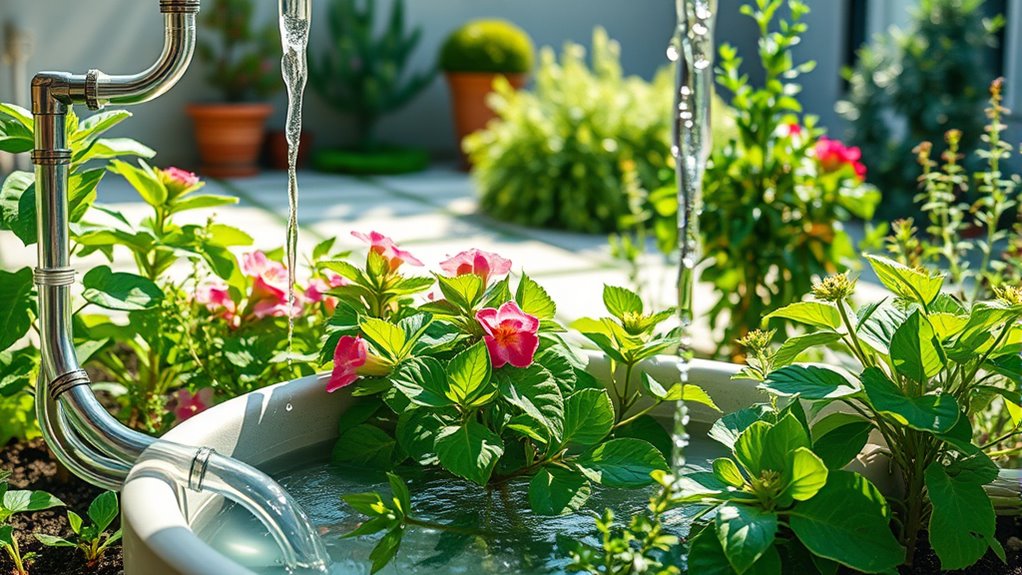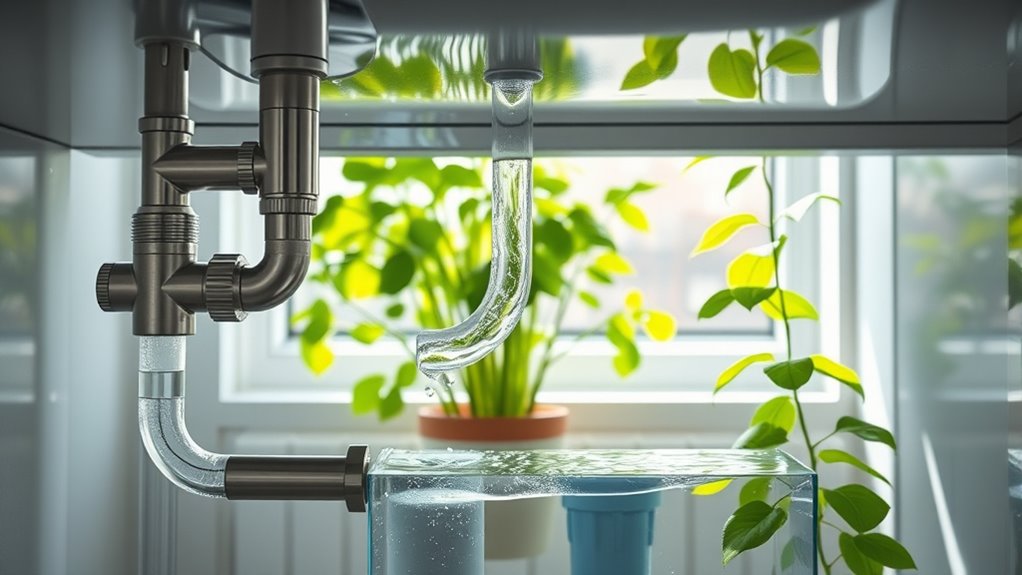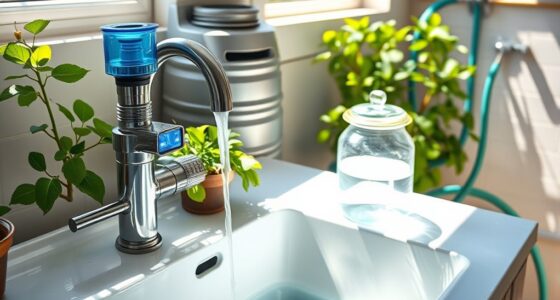Greywater reuse is a smart way to conserve water around your home by recycling water from sinks, showers, and laundry for irrigation or other uses. Installing eco-friendly fixtures like low-flow showerheads and maintaining proper filtration guarantees safety and efficiency. Simple habits, like fixing leaks and running full loads, further reduce waste. Embracing these strategies not only saves water and lowers your bills but also protects essential resources. Discover more ways to make the most of greywater and boost your sustainability efforts.
Key Takeaways
- Reuse greywater from sinks, showers, and laundry to conserve water and reduce environmental impact.
- Install eco-friendly fixtures like low-flow showerheads to minimize greywater generation.
- Use proper filtration and ensure immediate use in irrigation to maintain safety and prevent bacteria buildup.
- Implement additional water-saving practices such as fixing leaks and collecting rainwater.
- Conduct home audits and adopt integrated strategies to maximize water efficiency and sustainability.

Have you ever considered how reused greywater can help conserve water and reduce your environmental footprint? Greywater, which comes from sinks, showers, and laundry, represents a valuable resource that often goes to waste. Instead of letting it drain away, you can repurpose this water for watering plants, flushing toilets, or other non-potable uses. Doing so not only cuts down on overall water consumption but also eases the pressure on local water supplies, especially during droughts or in arid regions.
To make the most of greywater, installing eco friendly fixtures is a smart move. These fixtures are designed to minimize water use without sacrificing performance. For example, low-flow showerheads and faucets can considerably reduce the amount of greywater generated, making it easier to manage and reuse. Additionally, using water-efficient appliances and fixtures helps you implement water saving tips that benefit both your household budget and the environment. It’s a simple step that has a big impact—saving gallons of water daily and reducing the energy needed to treat and pump fresh water.
Once you’ve set up a greywater system, it’s imperative to consider proper filtration and safety measures. You don’t want contaminants or harmful bacteria to accumulate, so using appropriate filters and safe disposal methods becomes essential. Regular maintenance ensures the system functions efficiently and keeps your plants healthy when you reuse greywater for irrigation. Keep in mind that greywater should never be stored for long periods, as bacteria can grow quickly. Instead, direct it immediately to your garden or irrigation system to prevent any health hazards.
Incorporating greywater reuse into your routine also involves adopting other water saving tips. For instance, running full loads in your washing machine and dishwasher conserves water, while fixing leaks promptly prevents unnecessary waste. Collecting rainwater to supplement greywater use is another effective strategy, further reducing reliance on municipal water sources. By combining these practices, you create a more sustainable household that values resourcefulness.
Additionally, regularly evaluating your home’s water efficiency through home energy audits can help identify areas where water and energy are being wasted, allowing you to make targeted improvements that benefit both your household and the environment. Ultimately, greywater reuse is about making smarter choices with the water you already use. Small adjustments—like installing eco friendly fixtures and following water saving tips—can lead to substantial conservation benefits. Not only will you lower your water bill, but you’ll also contribute to a healthier planet. It’s a straightforward, practical way to ensure that good water doesn’t go to waste, helping you live more sustainably and protect essential water resources for future generations.
Frequently Asked Questions
How Cost-Effective Is Greywater Reuse for Average Households?
You might find greywater reuse quite cost-effective for your household. While it requires an initial investment in plumbing and filtration systems, the ongoing cost savings from reduced water bills can make up for it over time. Plus, you’ll help conserve water and reduce your environmental impact. Overall, with proper planning, greywater reuse can be a smart, economical choice that benefits your wallet and the planet.
Are There Specific Plants That Thrive With Greywater Irrigation?
Imagine watering your garden with greywater and seeing lush, thriving plants. Certain plants, like ornamental grasses or fruit trees, are highly compatible with greywater irrigation due to their tolerance for diverse water quality. For example, a homeowner in California successfully grew citrus trees using greywater, demonstrating good plant compatibility. You should choose plants that tolerate variable water quality, ensuring your garden flourishes without harm.
What Are the Potential Health Risks Associated With Greywater Reuse?
You should be aware that greywater reuse carries potential health risks, mainly contamination risks and pathogen transmission. If not properly treated or managed, greywater can harbor bacteria, viruses, and other pathogens that may cause illness. To minimize these risks, guarantee you use appropriate filtration and treatment methods, avoid contact with certain household contaminants, and follow safety guidelines. Proper handling and maintenance keep your greywater system safe and effective.
How Do Local Regulations Impact Greywater System Installations?
Like Pandora’s box, local regulations can complicate greywater system installations. You need to navigate legal restrictions and permitting requirements carefully, as they vary widely by location. Some areas encourage reuse with clear guidelines, while others impose strict bans. Checking with local authorities guarantees your system complies, preventing fines or removal. Staying informed helps you safely reuse greywater, turning a potential challenge into an eco-friendly opportunity.
Can Greywater Reuse Be Integrated With Existing Plumbing Systems?
You can definitely integrate greywater reuse with your existing plumbing systems, but be prepared for some retrofit challenges. Plumbing integration involves modifying or adding connections to reroute greywater safely, which may require permits and professional expertise. You’ll need to take into account local regulations and ensure the system is properly separated from potable water lines. While it’s a practical solution, thorough planning helps you overcome retrofit challenges and ensures efficient, compliant greywater reuse.
Conclusion
By reusing greywater, you can cut your household water consumption by up to 30%, making a meaningful environmental impact. It’s a simple step that not only conserves precious resources but also saves you money on your utility bills. Remember, with over 80% of household wastewater being greywater, it’s a smart move to treat and reuse it responsibly. Don’t let good water go to waste—embrace greywater reuse and help protect our planet today.










